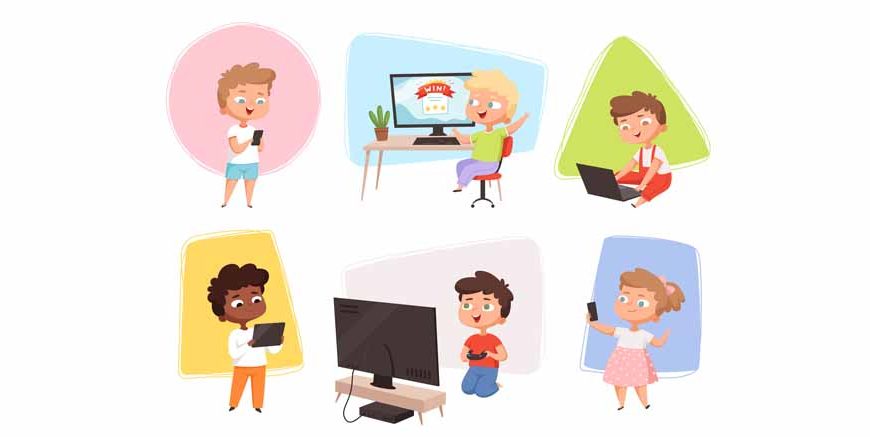In today’s world, it feels almost impossible to avoid screens. From online classes to YouTube cartoons, from video games to family movie nights, devices have become part of everyday life. Parents often find themselves wondering, “Is this much screen time really okay for my child?”
The truth is, screen time for kids is not inherently bad when used in moderation for learning or connecting with loved ones. But excessive use can have long-term effects on their growth, focus, and even their emotions. That’s why knowing how to reduce screen time for kids without constant fights is one of the most valuable skills parents can develop today.
In this blog, we will discuss why screen time is bad for kids, what the recommended screen time for kids is, and 15 practical ways for limiting screen time for kids in a way that feels natural, not forced.
Why Screen Time is Harmful for Children
Screens stimulate the brain differently than real-life experiences because they give it quick bursts of excitement through bright colours. While digital devices can help children learn, too much can create a dependency on fast-moving visuals and constant entertainment. Some major ways excess screen time can hamper a child’s growth include:
- Physical health: Long hours of sitting can lead to poor posture, reduced physical activity, and even eye strain.
- Sleep disruption: Blue light from devices delays melatonin production, making it harder for children to fall asleep.
- Attention span issues: Constant exposure to quick, colourful visuals can make slower-paced real-world activities seem boring.
Social skills gap: Less face-to-face interaction means fewer chances to develop empathy, patience, and conflict resolution skills. - Emotional regulation problems: Children who turn to screens for comfort may struggle to cope with boredom or frustration in healthier ways.
Also Read: How Screen Time Affects Children’s Behavior and Development
Recommended Screen Time for Kids
The average screen time for children today can be surprisingly high. Studies reveal that many kids spend far more time on digital devices outside of schoolwork than experts recommend, often exceeding healthy limits by a wide margin.
Here are the expert guidelines from the World Health Organization and the American Academy of Pediatrics:
- Under 2 years: Ideally no screen time at all, except for occasional video calls with family.
- 2–5 years: Maximum of 1 hour per day, focusing on high-quality, age-appropriate content.
- 6 years and above: Consistent limits, ensuring balance between digital and offline activities.
Understanding these limits is the first step toward deciding how to limit screen time for kids in your own home.
The 30-30-30 Rule for Healthier Screen Habits
One simple yet effective tip to protect your child’s eyes while using digital devices is the 30-30-30 rule. It works like this: every 30 minutes of screen time, encourage your child to look at something 30 feet away for at least 30 seconds. This short break relaxes the eye muscles, reduces strain, and helps prevent headaches or blurred vision caused by prolonged focus on screens. You can make it fun by turning it into a mini “look outside” challenge, where kids spot a bird, a cloud, or a moving car during their break. Over time, this habit can become a natural part of your child’s screen use, supporting healthier vision and overall well-being.
15 Smart, Practical, and Relatable Ways to Limit Screen Time for Kids
Now, let’s get into the real-life solutions, ideas that fit naturally into your family’s lifestyle and don’t feel like punishment.
- Start the Day Without Screens
- Create a “Curiosity Box” for Bored Moments
- Make a Family Screen Agreement
- Break Screen Time Into Short Sessions
- Offer Engaging Alternatives That Truly Compete
- Be a Role Model for Balanced Screen Use
- Use Technology to Control Technology
- Encourage Outdoor Adventures
- Indoor Games Can Reduce Screen Time
- Turn Cooking Into Quality Time
- Build a Cozy Reading Corner
- Nurture Offline Hobbies
- Create a Calming Bedtime Routine
- Introduce Family Game Nights
- Arrange Screen-Free Playdates
The first hour after waking sets the tone for the day. Instead of turning on cartoons, create a morning ritual, play music, do stretches together, or let kids help set the breakfast table. For example, you could have a “sun salutation challenge” where each family member makes up a funny yoga pose. This energises children while keeping devices away from the breakfast table.
Also Read: Yoga For Kids- A Complete Guide on 10 Easy Yoga Poses and Benefits
When children say “I’m bored” and you’re tempted to hand them a tablet, redirect them to a special box filled with puzzles, art supplies, or sensory play items. You could refresh the contents every week with low-cost items like playdough, stickers, or story cubes. This keeps curiosity alive and screens out of sight.
Children are more likely to follow the limits they create for themselves. Whenever setting a limitation, include it and explain why it is necessary. Sit together and decide: “No devices at mealtimes,” or “TV only after homework is done.” You can even make a colourful poster of the rules and hang it on the fridge. When limits feel like teamwork instead of orders, children show more cooperation.
Instead of long, uninterrupted device use, introduce “screen breaks” every 20–30 minutes. Even just standing up, getting a drink, or doing a quick game of “Simon Says” can prevent zoning out and reduce overuse.
Simply saying “read a book” might not work if the book doesn’t excite them. Offer alternatives that match your child’s interests. A child who loves racing games might enjoy building a cardboard car track, while a child who loves cooking videos might like making a simple fruit salad with you.
If your child sees you scrolling during dinner, they’ll assume that’s okay. Try keeping your own phone away during family time. When parents are present and engaged, children are more likely to mirror that behaviour.
Timers, parental control apps, and built-in device limits can make reducing screen time less of a battle. When a device switches off automatically after a set time, you’re no longer the “bad guy.”
Plan daily outdoor time, even if it’s just 20 minutes. Activities like cycling, ball games, nature walks, or gardening keep kids physically active and connected to the natural world. You could even start a weekend “outdoor scavenger hunt” to keep it fun.
When we talk about how to limit screen time for kids, we often focus on sending them outdoors, but rainy days, hot afternoons, or late evenings call for indoor play. Indoor games are a perfect way to keep children engaged without turning to a device.
Games like carrom, chess, building blocks, Pictionary card game, and hide-and-seek (yes, it works indoors too!) encourage active participation, problem-solving, and creative thinking. Unlike passive screen use, indoor games require children to think ahead, remember rules, and often work as a team. This builds social skills, patience, and resilience.
Also Read: 11 Fun and Educational Indoor Activities for 1-Year-Olds
Involving children in cooking helps them learn life skills while keeping them away from screens. Even toddlers can help rinse vegetables, while older kids can measure ingredients. The sense of accomplishment makes them want to join you again.
A small, inviting reading nook with cushions, blankets, and a basket of books can encourage children to read instead of reaching for devices. You can also make reading interactive by acting out parts of the story together.
Hobbies like painting, dancing, music, sports, or gardening give children something to look forward to beyond screens. Let them choose their own hobbies, even if it’s something unusual like origami or astronomy, it’s the excitement that matters.
No screens at least one hour before bed. Instead, replace them with gentle rituals like storytelling, calming music, or gratitude sharing. This helps the brain wind down and improves sleep quality.
Board games, card games, and role-playing activities create bonding moments while giving kids a break from digital devices. Make it a weekly ritual so it becomes something the whole family anticipates.
Coordinate with other parents to plan device-free meetups. Activities like building forts, water play, or group crafts keep kids engaged without screens and strengthen real-world friendships.
Also Read: Why Screen Time is Not the Best Babysitter for Your Child
Conclusion
Limiting screen time for kids isn’t about strict control, it’s about creating a balanced lifestyle that nurtures their physical health, mental growth, and emotional well-being. With these 15 smartest ways to reduce screen time for kids, you can guide your child towards healthier habits while strengthening family bonds. For parents looking for practical ways to avoid screen time, indoor games also offer flexibility. They can be set up quickly, don’t require a large space, and can be tailored to your child’s age and interest. Over time, these activities become part of your family’s rhythm, making screens less of a default choice.
At EuroKids Preschool, we believe in holistic child development, blending technology with meaningful offline experiences. To know more about your kids’ well-being beyond education, you can also check out EuroKids Blogs.
Related Blogs:
- Do You Believe Educational Apps Help Children to Learn? Educational apps have become a common tool for modern learning, but do they really help children understand and retain knowledge? This blog explores the benefits, possible drawbacks, and the right approach for using educational apps to enhance your child’s learning experience.
- When is the Right Time for Children to Have a Phone? Giving a child their first phone is a big decision for parents. In this blog, we discuss the advantages and disadvantages of early phone ownership, helping you make an informed choice about the right time for your child to step into the world of mobile communication.
- Unravelling the Impact of TV on Children’s Vision: From cartoons to educational programmes, television plays a big role in children’s lives. But excessive screen time can affect their eye health. This blog uncovers the effects of TV on children’s vision and shares tips to ensure safe and healthy viewing habits.
















